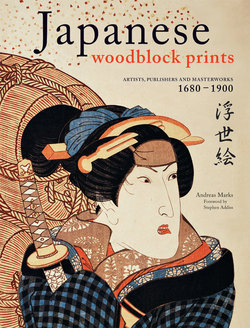Читать книгу Japanese Woodblock Prints - Andreas Marks - Страница 30
На сайте Литреса книга снята с продажи.
ОглавлениеUtamaro
1753–1806
Family name: Kitagawa. Common name: Yūsuke, Ichitarō(?). Art surname: Kitagawa (three characters; since c.1783). Artist names: Toyoaki, Utamaro (since 1781). Art names on paintings: Sekiyō (1770), Mokuen, Murasakiya. Poet name: Fude no Ayamaru.
Not much is known about the early years of Utamaro (also possibly read as Utamaru), one of the better-known print artists outside Japan. Born in 1753, he studied under the painter Toriyama Sekien (1712–1788). His earliest known work is believed to be a simple illustration of aubergines, signed Sekiyō, in the 1770 haikai anthology “Eternal Spring” (Chiyo no haru). The next known works are unpretentious book illustrations and a few actor prints that appeared starting in 1775 under the name Kitagawa Toyoaki.
At a banquet in the autumn of 1782, he officially announced his name change to Utamaro. In the book “A Brief History of the Exploits of a Great Dandy” (Minari daitsūjin ryaku engi) from 1781, the name Utamaro already appears which leads either to the conclusion that this book was actually not published until 1783 or that Utamaro used his new name already before the official announcement. Be that as it may, at that time Utamaro lived in Sukiyachō Shinobugaoka and he had already met with the publisher Tsutaya Jūzaburō with whom he would build a long lasting and, for both sides, very fruitful association. It is believed that Utamaro moved to Tsutaya in 1783 where he lived until Tsutaya died in 1794. The young Utamaro first produced actor prints in the style of Katsukawa Shunshō but soon started to specialize in beautiful women, influenced by Torii Kiyonaga and Kitao Masanobu who also lived at Tsutaya’s house. Utamaro’s style evolved steadily during the 1780s and early 1790s when he established his own unique style replacing Kiyonaga as the foremost designer of prints of beautiful women. He became a central figure of the literary and artistic world of Edo and is highly praised for his remarkably sensual and elegant way portraying single women in ōkubi-e (“large-head pictures”) but became also very successful in capturing erotic scenes. An example of such an ōkubi-e can be seen in the figure to the right from the series “Seven Komachis from the Pleasure Quarters” (Seirō nana Komachi), issued around 1796.
During his heyday Utamaro captured the most fragile nuances of emotional states in his designs but then ceased to keep up with the changing taste so by the early 1800s his designs are merely repetitions. His print designs were issued by almost 60 different publishers, most importantly Tsutaya Jūzaburō and Izumiya Ichibei. He produced over 120 series of beautiful women, like “Ten Types in the Physiognomic Study of Women” (Fujin sōgaku juttai; c.1792), “Five Shades of Ink in the Northern Quarter” (Hokkoku goshiki zumi; c.1794–95), or “Twelve Hours of the Green Houses” (Seirō jūni toki; c.1794), all in all over two thousand prints. Furthermore he created approximately 30 paintings, and illustrations to almost one hundred books, e.g. “A Picture-book of Selected Insects” (Ehon mushi erabi; 1788) or “The Poem of the Pillow” (Utamakura; 1788). In the fifth month of 1804, he was jailed and upon his release became one of the artists who were manacled for fifty days for including the events and identifiable figures from the Ehon Taikōki (Illustrated Chronicles of the Regent) in his prints, which was forbidden by law.
Utamaro established his own school and his students continued his style, amongst them Tsukimaro, Hidemaro, Utamaro II, Bunrō, and Kiyomine. Utamaro died, aged 53, on the 20th day of the ninth month 1806. His grave stele is located at Senkōji and his posthumous Buddhist name is Shūen Ryōkyō Shinji.
c.1796 “Courtesan Hanamurasaki of the Tamaya” (Tamaya uchi Hanamurasaki), from the series “Seven Komachis from the Green Houses” (Seirō nana Komachi). ōban. Publisher: Sen-Sa. Collection Peter Rieder. Ukiyo-e shūka 3 (1978), no. 285.6-1.
1805 “Konami, Honzō’s daughter” (Honzō no musume Konami), from the series “Honorable Contest of the Treasury of Loyal Retainers” (Chūshingura misao kurabe). ōban. Publisher: Nishimuraya Chō. Asian Art Museum, National Museums in Berlin. Ukiyo-e shūka 3 (1978), no. 361.2.
c.1805 “Courtesan Mantoka of the Tamaya” (Tamaya uchi Mantoka). ōban. Publisher: Ibaya Kyūbei. Collection Peter Rieder. Ukiyo-e shūka 3 (1978), no. 541.1.
c.1790s “One hundred tales” (Hyaku monogatari). ōban. Publisher: ōmiya Gonkurō. Asian Art Museum, National Museums in Berlin. Unlisted in Ukiyo-e shūka 3 (1978).
1802 "Act two” (Ni danme), from the series “Treasury of Loyal Retainers” (Chūshingura). ōban. Publisher: Nishimuraya Chō. Library of Congress. Ukiyo-e shūka 3 (1978), no. 368.2.
1803 Courtesan breast-feeding her child, from the series “Famous scenic places, Twelve types of beautiful women” (Meisho fūkei, Bijin jūni sō). ōban. Asian Art Museum, National Museums in Berlin. Ukiyo-e shūka 3 (1978), no. 585.5.
c.1797–98 Young man shaving the neck of a courtesan, from the series “Elegant five-needled pine” (Fūryū goyō no matsu). ōban. Unidentified publisher. Asian Art Museum, National Museums in Berlin. Ukiyo-e shūka 3 (1978), no. 533.2-1.
1801 “Act 8” (Hachi danme), from the series “Treasury of Loyal Retainers” (Chūshingura). Aiban. Publisher: Nishimuraya Yohachi. Library of Congress. Ukiyo-e shūka 3 (1978), no. 380.8.
